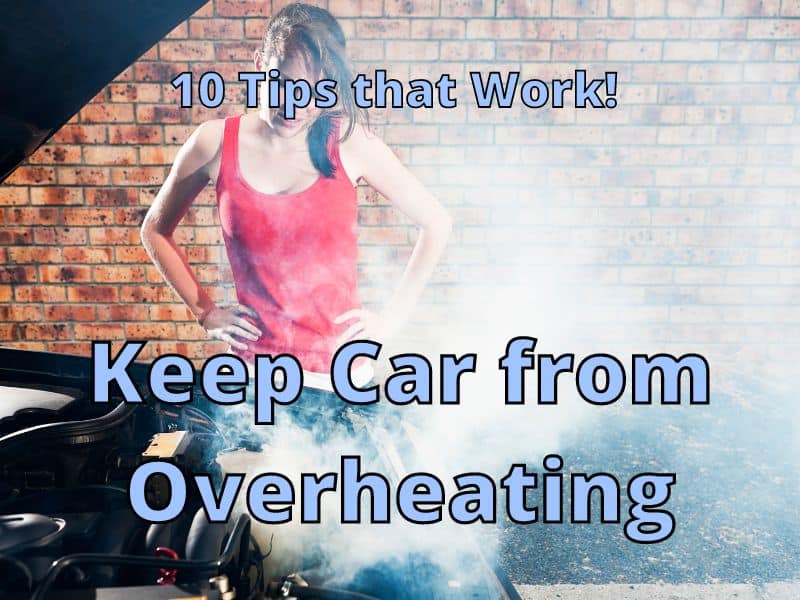Your vehicle overheating is a serious indication that something is wrong. Every car is prone to overheating at some point in its life, especially those in warmer climates with little vegetation and shade available. Many factors contribute to overheating, and many remedies are available for immediate and long-term avoidance of overheating.
Each type of car is vulnerable to overheating, including typical combustion-run vehicles (powered by fuel) and Electric Vehicles. Coolant and fans are required to keep the central engine cool in any car. However, here are 10 tips that work to prevent a car from overheating:
- Find shade when possible
- Use window shades
- Professionally tint your windows
- When parked – Keep windows cracked slightly
- Always monitor the temperature gauge
- Keep Coolant in your car
- If driving – Turn on the heater
- When cleaning – Use proper products & Methods
- Wax your car often
- Take it in for regular maintenance
If you see the temperature gauge reaching a dangerous level more frequently than you would like, use this guide to understand the ins and out of your vehicle’s coolant needs. We’ll walk you step-by-step through troubleshooting and preventative tips for the future. By the end, you’ll know if a mechanic is needed, but you’ll likely be able to handle this on your own.
Introduction to Your Car Overheating

All cars are susceptible to overheating at some point. There is an optimal temperature range where your car is protected for:
- The safest functionality
- Prevention from interior fading
- And the most extended longevity for your vehicle
Please note beforehand – Do not continue to drive if your car is overheating. If you cannot individually repair it, always call roadside assistance.
How to Keep Your Car from Overheating? 10 Tips that Work!
Your typical combustion-run car (powered by fuel), as well as Electric Vehicles – each type of car is vulnerable to overheating.
Any type of vehicle will require Coolant and fans to keep the central engine cool. The temperature gauge will measure these fans and translates this data back to the ECU (Engine Control Unit). The ECU uses the information processed through the vehicle to communicate with the engine. This keeps the engine running.
Keep everything communicating clearly with the ECU and follow these 10 tips that help prevent future vehicle overheating. You can prevent overheating and keep your car cool by following ways:
#1 Find Shade When Possible

This is a top-ranking solution for all car owners to take advantage of. Especially in warmer climates or during the Summer months, this must be taken seriously as not only can the engine of your car overheat, but also the interior.
Researchers at the University of California San Diego found that:
“If a car is parked in the sun on a Summer day, the interior temperature can reach 116-degrees Fahrenheit, and the dashboard can exceed 165-degrees Fahrenheit in approximately one hour – The time it can take for a young child trapped in a car to suffer fatal injuries.”
Parking your car in the shade whenever possible, will prevent:
- Cracking of the interior and dash
- Lowered stress on your interior functions, radiator, and fans
- Engine overheating
While also extending the life span and functionality of your vehicle.
Habitual parking in a shady or sheltered location can extend the lifespan of your vehicle because you are keeping all fluids and oils stable. This leads to a more well-functioning vehicle.
Always park in a garage if available because this degree of shade protection will:
- Prevent fading from UV rays on the interior.
- Oxidation from weathering and moisture on your paint job.
- Rust and corrosion into the interior mechanisms.
#2 Use Window Shades
Purchasing a Car Sunshade (AD) is an excellent way to reflect powerful UV rays back outwards, away from your car. Without a light refractor to redistribute those light rays, a greenhouse effect will cause the extreme temperatures to rapidly raise.
If you have children or a full car, also consider Side Sunshades (4px) (AD) for your backseat riders as well. Consider purchasing custom shades that are suited to your car’s model. These can often be purchased at the dealership where your model sold.
#3 Professionally Tint Your Windows

An upgrade above window shades, you can also have them professionally done.
A professional window tint adds a layer of film to the glass, which makes it darker and tinted. When you can’t see inside of someone’s vehicle, this means they’ve had the windows tinted. This film will keep the interior much cooler and protect the family from UVB and UVA rays that lead to sunburn and skin damage.
(Be careful not to tint too far, as this can be illegal. Police need to be able to see your vehicle slightly, but the professional tinting expert will be aware of this). In Texas, for example:
“Vehicle windows in Texas are allowed to have tint, but the amount of tint depends on the window. No tint is allowed on the front windshield below the AS-1 line (or the top five inches), and tinting on the front side windows must allow 25 percent or more of light in.”
This will vary from state to state but communicate with your tinting professional to find a tinting degree that works for you and remains legal.
A basic window tint on Angie’s List is only $99, but this could range upwards to the thousands depending on your vehicle and the quality of your window tint preference.
The benefits of a window tint (as compared to a more-temporary solution of a window shade) include the following:
- Lowers the temperature inside your vehicle
- Increased privacy
- Prevents UV rays from weakening the car aesthetically and mechanically)
- Prevents the risk of shattered glass
- Protects the:
- Dashboard
- Carpeting
- Leather
- And all upholstery – Protects Against
- Fading
- Cracking
- and Overall damage
#4 When Parked – Keep Windows Cracked Slightly
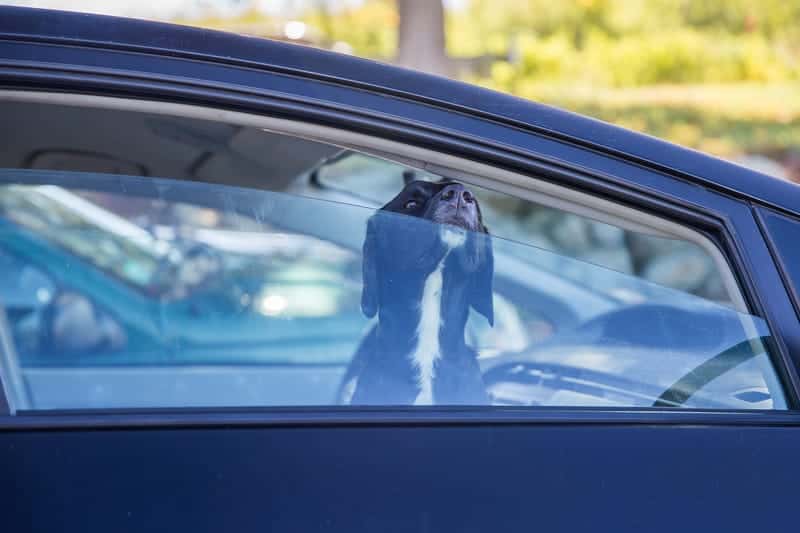
To follow up on any vehicle’s propensity for greenhouse gas effects. Jonathan Strickland on How it Works compares the atmosphere to the inside heat of your car:
“The heat radiated by the seats is a different wavelength than the light of the sun that made it through the windows in the first place. So a certain amount of energy is going in, and less energy is going out. The result is a gradual increase in the temperature inside your car.”
The only real release for this heat is ventilation and airflow. Do this by cracking your windows slightly when you plan to leave them in a hot parking lot or driveway for extended periods. You can also crack your sunroof slightly and combine this with your tinted windows or less-permanent window shades.
#5 Always Monitor the Temperature Gauge

Near the speedometer, you will clearly see a gauge that states F-C (Fahrenheit to Celsius) or H-C (Hot to Cold). Keep an eye on this with the same regularity and normalcy as you watch the gas tank gauge.
Use the temperature gauge throughout hot Summer days to determine if you’re pushing your vehicle too hard.
If the car is reading as too hot, you shouldn’t ignore this. It doesn’t have to be smoking and steaming for your car to communicate something important. If the radar seems too high or close to hot (at around 80-100% hot, rather than being neutral or approximately 60% hot), the steps you can take to cool it off are:
- Slow down.
- Turn off the air conditioning.
- Don’t pedal or brake so hard.
- Brake less frequently or firmly.
- Park for a while if necessary.
#6 Keep Coolant in Your Car
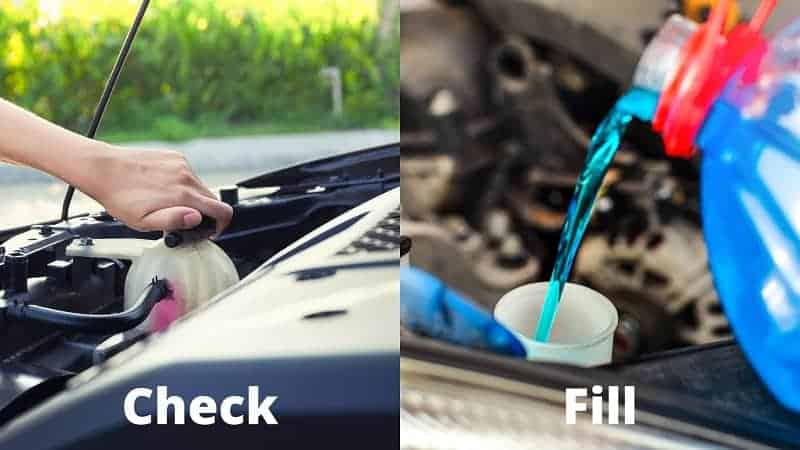
The internal functions are left cool enough to operate through the combination of fans and antifreeze coolant.
Antifreeze is an ingredient used within Coolant (with Coolant often being 50% antifreeze, 50% water).
Tip for safety – Never fill up Coolant while your car is hot. It can just evaporate and be rendered useless, also with the potential to burn yourself. Wait for the engine to cool before ever adding any coolant or water.
The steps to check this and fill your coolant mixture if needed are as follows:
- Find the plastic tank of Coolant by the radiator.
- If the tank is not translucent, you may need to remove the screw top to see how filled the Coolant is inside. Twist the cap counterclockwise to remove it from and view the coolant tank.
- Read the markings that indicate the proper amount of antifreeze.
- If it is low, fill it with your spare bottle of Coolant (AD).
#7 Turn on the Heater When Driving
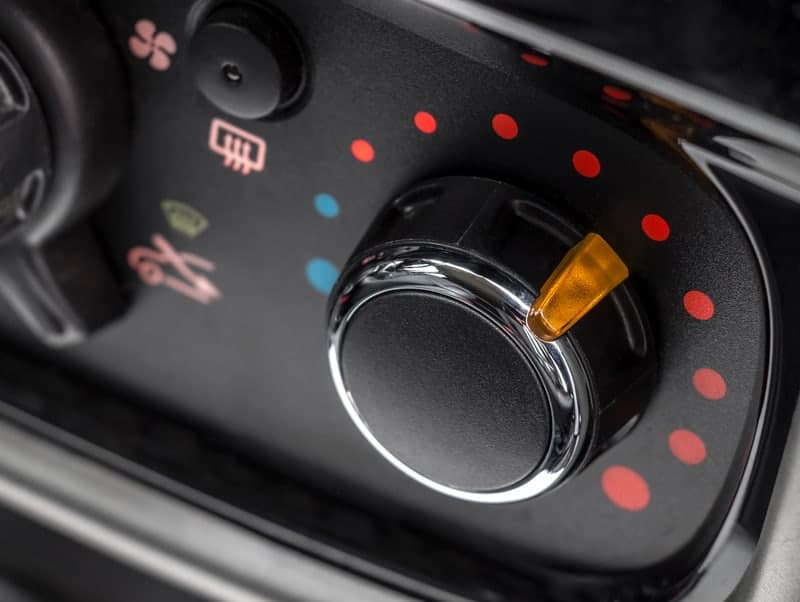
This may sound counterintuitive, but the air-conditioning is connected to the engine, while the heater is not.
Turing on the air-conditioner will worsen the problem and make your engine even hotter.
Conversely, turning on the heater will pull air away from the engine. This will pull air out of the engine and immediately cool down your interior functions.
This technique will be ideal if you’re stuck in traffic and can’t pull over immediately.
#8 Use Proper Products & Methods When Cleaning
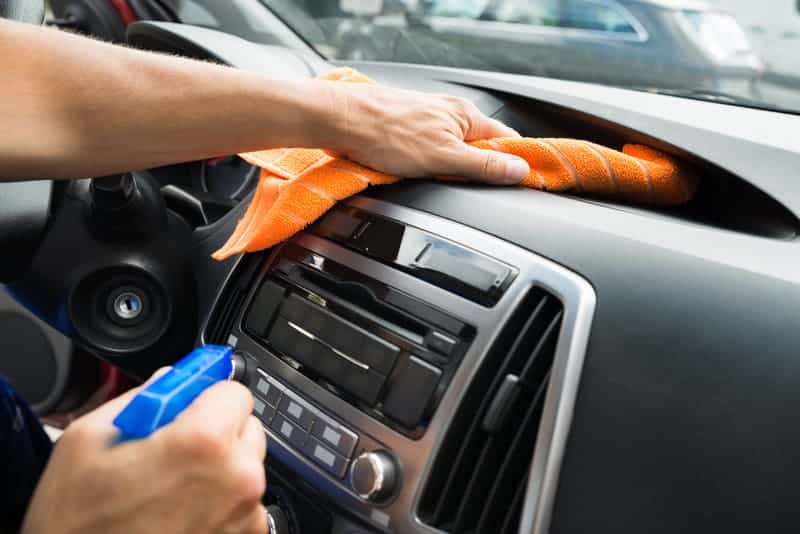
Utilize soap specifically made for Cars, and don’t wash the car in the sun. The powerful UV rays will damage your paint coat, increasing the risk of your interior overheating. This also goes for waxing because the sunlight will beat down on your freshly-waxed car and undo any good you’ve done.
Tips for properly cleaning your car to protect against heat are:
- Avoid washing in direct sunlight.
- Use a gloss product for the dashboard, which will reduce glare (reducing greenhouse effects)
- Use a dashboard protector or windshield sun protector such as TriNova UV Protectant Spray (AD) to strengthen your car’s internal chance against overheating.
- Use soap for distinguished proper purposes (if it is rust-remover, only uses on rust, etc.)
- After washing, dry thoroughly with a lint-free cloth. Any water can drip into the engine and cause moisture damage, such as
- Rust
- Corrosion
- and Mildew
- Warping
- Malfunction
#9 Wax Your Car
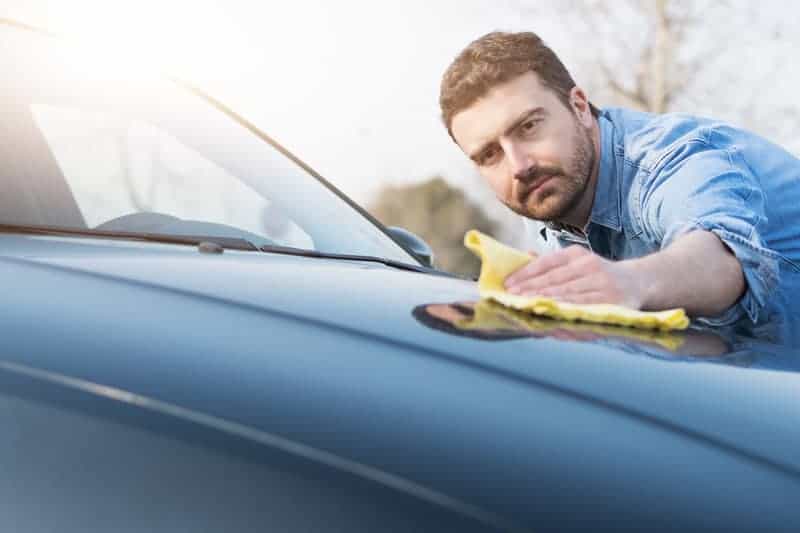
While waxing your car, just as with washing it, avoid direct sunlight, this adds an additional barrier of protection to your car against UV rays.
Purchase a wax that mentions being ‘UV Ray Protectant & Warp Safe Hybrid Wax.’ (AD)
#10 Take Your Car In for Regular Maintenance

Yes, sometimes the best thing to do is what is normally expected of a car owner. The best protection for your vehicle is to keep it running at 100%
Be sure that you are doing the bare minimum of:
- Regular annual inspections
- Oil changes every 3,000 to 5,000 miles (AAA describes that “It used to be normal to change the oil every 3,000 miles, but with modern lubricants, most engines today have recommended oil change intervals of 5,000 to 7,500 miles. Moreover, if your car’s engine requires full-synthetic motor oil, it might go as far as 15,000 miles between services.”
- Battery replacement (required every 3 to 4 years, potentially more frequently in warmer environments and for those that drive less gently).
- Radiator flushes to clean out the Coolant (about every 40,000 miles but regarding your vehicle’s manufacturer’s recommendation).
If you want to try to do it yourself (DIY), then you can try some tricks to fix it yourself. In this video, there are some common ways a mechanic might try to find out what is wrong with your car.
The Short- and Long-Term Impact of Your Car Overheating
The ideal temperature for your engine should be between 195 to 220 degrees Fahrenheit. Your car is impacted by conditions that are too hot and extreme temperatures that are too cold.
Overheating can cause:
- Engine damage (costly repair)
- Cylinder heads will warp (costly repair)
- Blown head gasket (costly repair)
- Melt holes in the piston
- Conflicts with combustion functionality
- Increased risk of an engine fire or potential explosion
- Heat functions get warped inside, possibly to the extent of being irreparable
- Expensive repairs that compound and accumulate
- Risk of fatality
These hazards are dangerous and can lead to an accident or, quite frankly, death if not taken seriously. What you’ll gain from this article is the ability to troubleshoot and repair the most common overheating issues on your own.
Common Causes for a Vehicle Overheating
The main reasons that you will experience a car overheating are due to the following circumstances:
- Blocked coolant flow by a closed or broken thermostat (often a budget one in economic models)
- Not enough Coolant (keeping the fans, engine, and transmission cooled)
- Blown gasket (can be a cause or effect of temperature-related concerns)
- Coolant hose leak causing not enough Coolant
- Plugged heater core
- Malfunction causing too much Coolant to flow
- A damaged water pump that isn’t circulating Coolant
- The clamps on the hose are too loose.
- Cracked radiator (allowing antifreeze to leak)
- Clogged radiator (not allowing antifreeze to flow properly)
- Broken fans
- Not enough motor oil
- There is another problem causing major malfunction, enough to cease your car from being operational due to visible signs of heat distress.
The simple explanations are:
- Hot weather – The main reason your vehicle overheats is direct sunlight.
- UV ray exposure
- Often combined with greenhouse gas effects in a car with no cracked windows, ventilation, or air circulation (which greatly increases the temperature and UV impact).
It could be something wrong, or it could simply be too hot out for your vehicle to run as it should.
Indications That Your Car is Overheating
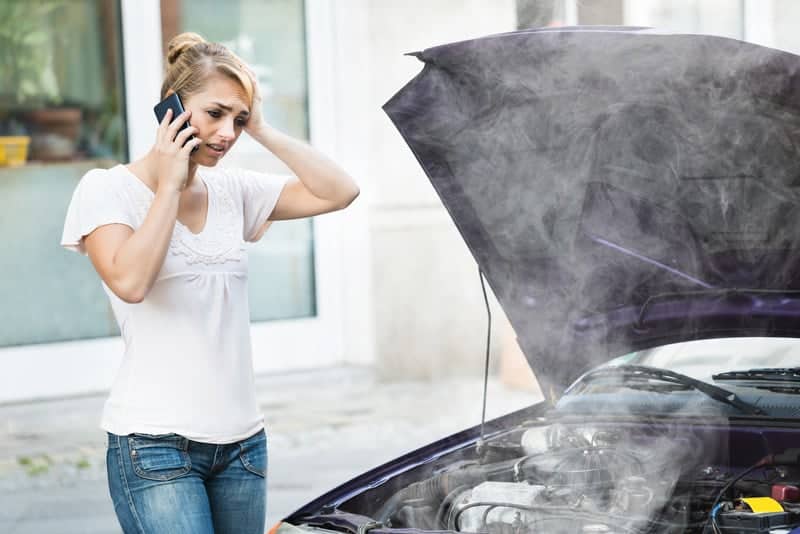
It should be quite evident if something is wrong, but your car usually offers some warning signs.
The indications to signal to you that your vehicle is overheating are:
- The temperature gauge begins in the middle but steadily moves up toward the peak setting. It may also fluctuate back and forth quickly and seem to be rapidly crashing or breaking.
- A warning light appears on your dash (the check engine light or maintenance required lights).
- You smell a burnt fragrance like:
- Burnt rubber.
- Melting plastic.
- Charred metal.
- It simply smells ‘hot.’
- You hear a ticking noise when you are at a stoplight or stop sign. This could be:
- A coolant leak hitting the ground.
- Or the engine is ticking because there is insufficient lubrication to propel each part sufficiently.
- You visibly see smoke or steam coming from the hood – This likely won’t happen unless you’ve pushed your car to the brink. You should pay attention to the subsequent warning signs before allowing it to get this bad. If you see smoke, you can immediately presume you’ll be paying for some level of repairs.
- You see Coolant leaking – This will be brightly colored (neon pink, green, purple, or blue) and should leak directly under your engine. Park in one spot and roll your car forward to see if any leaks are obvious. It will be easily distinguishable from gasoline’s fragrance and rainbow-translucent appearance.
- Your engine takes significantly longer to start.
- The car is offering less power than usual.
- Your car won’t start.
If Your Vehicle Overheats – Here’s What to Do!
If you’re driving and the vehicle overheats, action must be taken immediately. The steps to take when action is required are:
- Immediately pull over.
- Turn off the car and pop the hood.
- Check the coolant and fill up if low.
- If you have no coolant, use warm water.
The breakdown of these steps for further clarification are:
#1 Immediately Pull Over
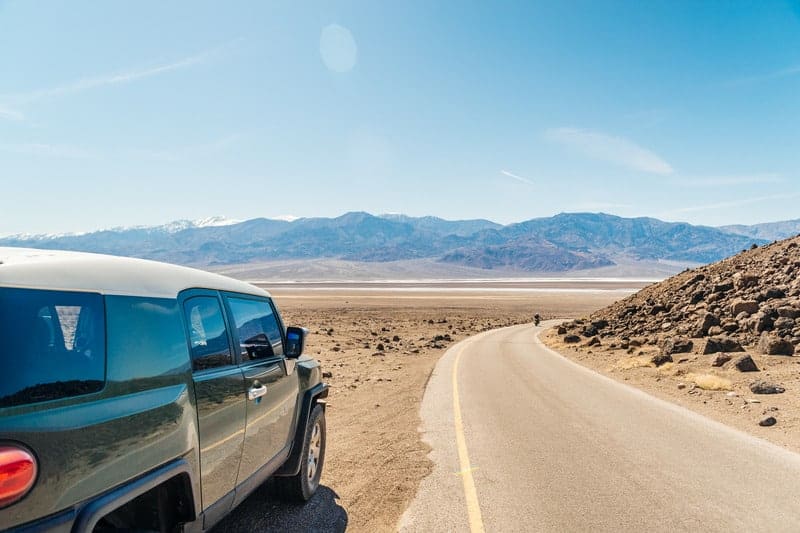
If you see the temperature gauge steadily rise – Your ECU is communicating for you to stop putting pressure on the engine. Do this by pulling over and avoiding further damage to your engine.
If You Can’t Pull Over Immediately:
- Try to stay off the brakes, as this friction increases the internal temperatures of your vehicle.
- Use the heater and avoid the air-conditioning.
- Turn on the floor vents, which will redirect the hot air that rises. Send the hot air outwards by using the heater and the floor vents combined to cool the car.
- Rev the engine – Again, this may seem counterintuitive, but by putting the car in neutral and revving the engine, you actually send water flowing through the radiator, which cools down the engine.
None of these measures will fix the problem, but they will help you drive a short distance to pull over safely or call roadside assistance.
#2 Turn Off the Car and Pop the Hood

Once you’ve safely pulled over, you’ll need to pop the hood to increase airflow and investigate. This should be done whether there is smoke coming from the hood or not because it allows the steam to disperse more quickly.
Allow your vehicle to cool for at least thirty minutes; some recommend up to an hour before even attempting to touch it. Turn off your car and all air-conditioning that makes the engine run harder.
The steps to pop your hood are as follows:
- Search inside your vehicle for the (press, push, or pull) lever. It will often be on the driver’s seat for easy accessibility, nearby where you would pop the trunk or gas valve (near the electricity charging port if on an electric vehicle).
- Pull until you hear it pop.
- Release the safety lever to pop the hood fully.
- Be careful not to touch anything too rapidly as it could be scorching hot/could burn you.
- Use the hood rod to prop your hood open. Be sure this is stable and securely keeping your hood open so that nothing falls on your head or fingers.
#3 Check Coolant and Fill Up If Low

After your vehicle has cooled down for half an hour, look for the translucent tank that is located near the radiator. These are the coolant reserves that keep the engine and transmission cooling.
(Steps to fill your tank with Coolant are listed above in the ‘How to Keep a Car from Overheating,’ section, under #7).
#4 If You Have No Coolant, Use Warm Water
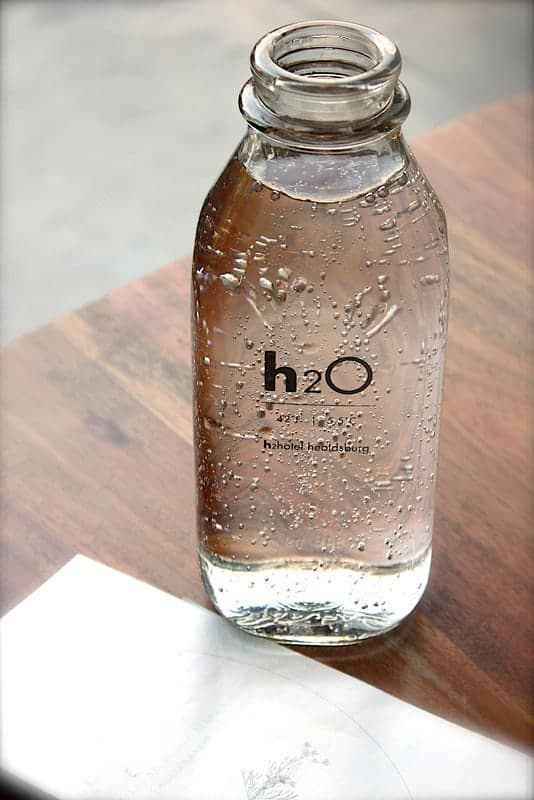
As mentioned, the coolant mixture is substantially made of water. Keep in mind that adding more water is thinning the antifreeze in further solvent (lowering its potency and effectiveness).
This is not a long-term fix; however, it is the ideal step to take in this instance. Adding a bit of water (when you don’t have Coolant) will at least allow you to drive to your local autobody shop.
Important note – Always use warm water and avoid cool water. Cold water against the overheated engine that is nearly 200 degrees Fahrenheit or more can cause engine cracking.
After filling the tank with your Coolant or water:
- Try to turn on your car if things are not smoking or if they seem cooled off.
- Read the temperature gauge at this point.
- Determine if the coolant/water is working as it’s supposed to.
At this point – Get your vehicle inspected as soon as possible. If this does not work, call a tow or roadside assistance.
Costs to Repair an Overheated Car
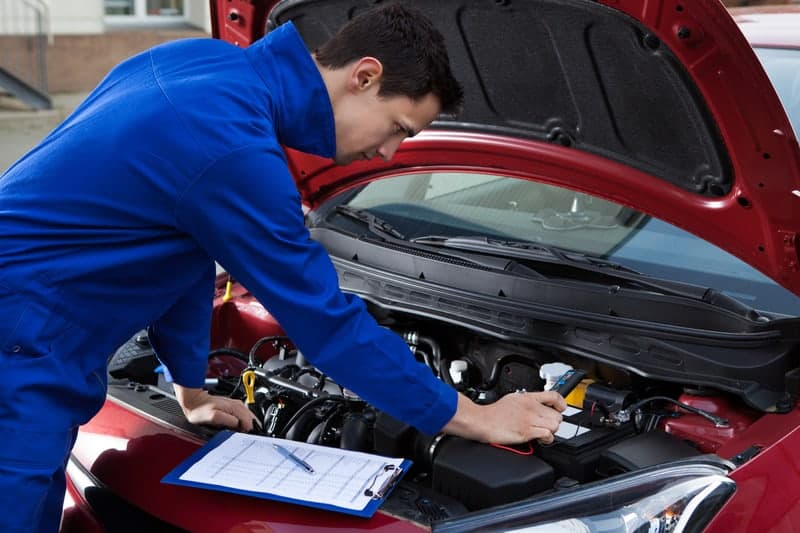
If your car has overheated, you should always take it in for inspection as soon as possible. You do not want to risk driving a dangerous car that’s overheating, flammable oils, and combustible chemicals. For your safety and those around you, get a professional inspection on a recently overheated vehicle.
The cost is difficult to determine based on the many possible reasons we’ve covered. Since there are so many possibilities, this warrants a wide range of prices.
To offer you some potential examples, you could look at paying:
- A cracked radiator can cost between $292 and $1193
- A water pump replacement can be between $500 and $1,500
- Replacing a radiator hose will be between $35 to $65
Please note – Your repairs will tend to be cheaper when addressed more immediately. The longer you leave a problem, the worse it will get and the costliest the repair will be.
Something that could be a $50 fix may compound into a $500 replacement to be necessary.
Take action before it gets this bad, and always heed your vehicle’s warning signs. If you try to DIY do it yourself, you may be able to save some money, but you should take the time to make sure you study how to do the procedures correctly.
Final Tips on Vehicle Maintenance
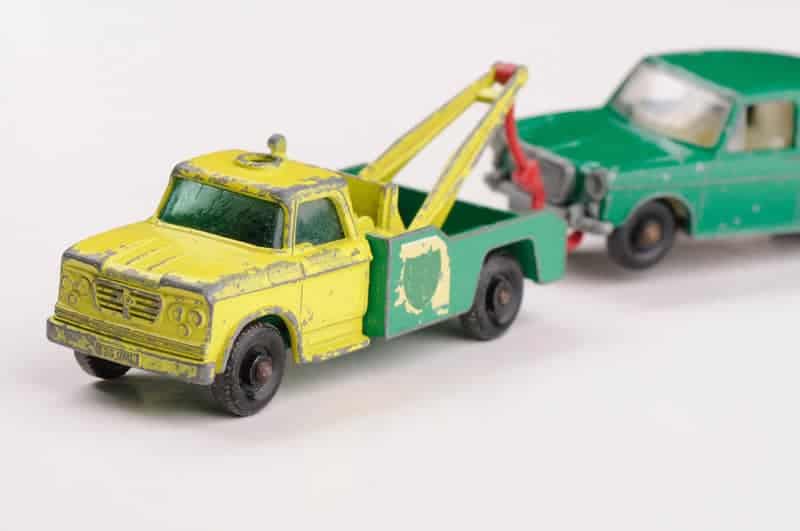
A few final tips to be aware of in maintaining your car against risks such as overheating are:
- Check if It’s Just Running Hot – Many cars ‘run hot,’ as they call it, but this is not overheating. It could be something such as owning an outdated model. Even if the car does not smoke and steam, be wary about pushing an easily ‘hot’ vehicle to its brink.
- Call a Tow – Don’t attempt to drive your vehicle if it’s overheated, as you could be risking your life. Call AAA or your roadside assistance provider to transport your ride to a reputable mechanic.
- Carry an Emergency Kit – With items such as:
- Coolant
- Water (distilled is best)
- Flashlight
- Roadside assistance emergency card (with account and customer service # on it)
- Rope
- Oil
- Spare tire
- Don’t Discount Exceptions to these rules – We covered many possibilities, but it could be something like:
- A plastic bag that is stuck in your exhaust and causes a burning odor.
- Plastic components attached to your car overheat and emit an oil film.
- A brake caliper impacting your brakes
- Or something seemingly unrelated.
These exceptions are why you must get an inspection if you see any warning signs.
Do not assume Coolant or water has fixed your problem or that your vehicle is safe to drive on these remedies alone. Only drive your car following the advice of your trusted mechanic.

